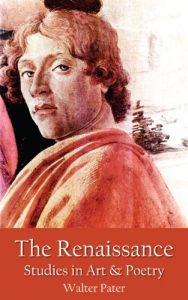It is in Italy, in the fifteenth century, that the interest of the Renaissance mainly lies,—in that solemn fifteenth century which can hardly be studied too much, not merely for its positive results in the things of the intellect and the imagination, its concrete works of art, its special and prominent personalities, with their profound aesthetic charm, but for its general spirit and character, for the ethical qualities of which it is a consummate type.
The various forms of intellectual activity which together make up the culture of an age, move for the most part from different starting-points, and by unconnected roads. As products of the same generation they partake indeed of a common character, and unconsciously illustrate each other; but of the producers themselves, each group is solitary, gaining what advantage or disadvantage there may be in intellectual isolation. Art and poetry, philosophy and the religious life, and that other life of refined pleasure and action in the open places of the world, are each of them confined to its own circle of ideas, and those who prosecute either of them are generally little curious of the thoughts of others. There come, however, from time to time, eras of more favourable conditions, in which the thoughts of men draw nearer together than is their wont, and the many interests of the intellectual world combine in one complete type of general culture. The fifteenth century in Italy is one of these happier eras; and what is sometimes said of the age of Pericles is true of that of Lorenzo:—it is an age productive in personalities, many-sided, centralised, complete. Here, artists and philosophers and those whom the action of the world has elevated and made keen, do not live in isolation, but breathe a common air, and catch light and heat from each other's thoughts. There is a spirit of general elevation and enlightenment in which all alike communicate. It is the unity of this spirit which gives unity to all the various products of the Renaissance; and it is to this intimate alliance with mind, this participation in the best thoughts which that age produced, that the art of Italy in the fifteenth century owes much of its grave dignity and influence.
The various forms of intellectual activity which together make up the culture of an age, move for the most part from different starting-points, and by unconnected roads. As products of the same generation they partake indeed of a common character, and unconsciously illustrate each other; but of the producers themselves, each group is solitary, gaining what advantage or disadvantage there may be in intellectual isolation. Art and poetry, philosophy and the religious life, and that other life of refined pleasure and action in the open places of the world, are each of them confined to its own circle of ideas, and those who prosecute either of them are generally little curious of the thoughts of others. There come, however, from time to time, eras of more favourable conditions, in which the thoughts of men draw nearer together than is their wont, and the many interests of the intellectual world combine in one complete type of general culture. The fifteenth century in Italy is one of these happier eras; and what is sometimes said of the age of Pericles is true of that of Lorenzo:—it is an age productive in personalities, many-sided, centralised, complete. Here, artists and philosophers and those whom the action of the world has elevated and made keen, do not live in isolation, but breathe a common air, and catch light and heat from each other's thoughts. There is a spirit of general elevation and enlightenment in which all alike communicate. It is the unity of this spirit which gives unity to all the various products of the Renaissance; and it is to this intimate alliance with mind, this participation in the best thoughts which that age produced, that the art of Italy in the fifteenth century owes much of its grave dignity and influence.






